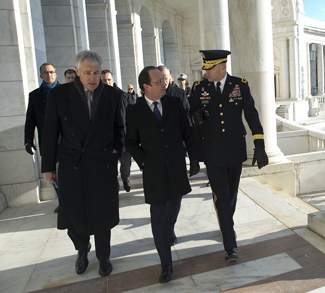The bombing of a Syrian factory near Homs last Wednesday marked the latest instance of Israeli airstrikes in Syria. In recent years, Israel has launched numerous strikes on targets in Syria belonging to the Iran-backed Lebanese Hezbollah and Syrian military forces.
It has been a longstanding policy of the Israeli government to use airstrikes to deter any potential threats and defend its national security interests. However, these airstrikes also run the risk of escalating tensions and even triggering a new regional war between Israel, the Syrian regime, Hezbollah, and other Iran-backed forces.
On November 1, Syrian reports claimed that Israeli jets struck a copper factory in Hisya in the countryside south of Homs. The factory was believed to have been producing rockets either for Hezbollah or the Syrian military. The following day, the Syrian government called for the United Nations to condemn Israel’s airstrikes.
Hezbollah has now gained experience with conducting offensive assaults and commanding militias with hundreds of fighters, which Israeli officials believe could be used against Israel in a future war.
While Israel declined to comment on the airstrikes, Israeli officials have stated that they would take any action to prevent the shipment of weapons to Hezbollah and the further entrenchment of Iranian forces in Syria. The Israeli Air Force claims to have targeted nearly 100 arms convoys belonging to Hezbollah and pro-Assad forces throughout the Syrian civil war. In addition, Israel allegedly killed several Hezbollah military commanders in Syria. Israel has also provided aid to Syrian rebel groups fighting Hezbollah and the Assad regime in southern Syria.
Syria and Israel: A history of conflict
Israel and Syria have been clashing intermittently since 1948. During the “Six Day War” in 1967, Israel captured the Golan Heights, a strategically valuable plateau region that overlooks northern Israel, from Syria. Syria attempted to reclaim the Golan Heights in 1973. The Syrian regime under Bashar al-Assad provided extensive military supplies to Hezbollah, including Russia-made anti-personnel and anti-tank missiles prior to the 2006 war between Hezbollah and Israel.
Both the Assad regime and Hezbollah are closely allied with Iran, which openly states its intent to destroy Israel. Hezbollah serves as a transnational sub-state proxy for Iran, and Syria is geographically and politically vital to Iran’s bid for regional hegemony. Iran provides military and financial support to both the Assad regime and Hezbollah. Hezbollah and Iran’s Islamic Revolutionary Guard Corps (IRGC) have deployed their forces to Syria to fight the Syrian rebels and the Islamic State of Iraq and al-Sham (ISIS) and prop up the Assad regime.
New threats and the ever-present risk of escalation
For Israel, Hezbollah and IRGC activities in Syria pose several major security threats. Israel has sought to stop the shipment and production of arms that Hezbollah could one day use against Israel, including chemical weapons. In addition, Hezbollah forces can use positions from within Syrian territory to launch attacks against Israel. Hezbollah and the IRGC are also entrenching their influence in Syria by training and commanding pro-regime militias, thus spreading their ideology and creating supportive militant networks similar to those of the Popular Mobilization Units in Iraq.
Furthermore, Hezbollah’s forces are gaining new combat experience in Syria. Historically, Hezbollah relied on guerrilla warfare and terrorist tactics when fighting the larger and better equipped Israeli army. While Hezbollah used conventional weapons and tactics in its 2006 war with Israel, Hezbollah still primarily relied on a defensive guerrilla warfare strategy within Lebanese territory. Hezbollah has now gained experience with conducting offensive assaults and commanding militias with hundreds of fighters, which Israeli officials believe could be used against Israel in a future war.
Nonetheless, the Syrian civil war has taken a toll on Hezbollah. Hezbollah has expended a significant amount of resources and has recorded at least 1,048 casualties in the conflict. Furthermore, Hezbollah’s involvement in Syria has harmed its reputation in Lebanon; the country’s Sunni opposition has criticized Hezbollah of sectarianism for supporting the Alawite-dominated Assad regime against Sunni rebels. On November 4, Lebanese Prime Minister Saad Hariri resigned, citing expanding Iranian influence in the region and in Lebanon via Hezbollah as his reasons for leaving office. Furthermore, Hezbollah and Syrian military forces are still spread out as they fight the remnants of the Syrian rebel opposition and ISIS, and would thus prefer to avoid a fight against Israel. Yet despite these risks, Hezbollah and the Assad regime are still threatening to retaliate against the Israeli attacks.
Regional and international powers could also mitigate or escalate tensions. Russia, which intervened in the Syrian civil war in support of the Assad regime, has sought to contain confrontations between Israel and Hezbollah and the regime to some degree. However, the United States has recently stepped up in its anti-Iranian rhetoric, and Saudi Arabia continues to support anti-Iranian opposition throughout the Middle East.
Perceived threats and miscalculations on both sides could escalate tensions to the brink of war. The next Israel-Hezbollah war is expected to cause even greater devastation than that witnessed in 2006, with Hezbollah having built up its capabilities in recent years. While tensions could be momentarily mitigated, they are unlikely to dissipate as Iran and its allies strengthen their positions in the region and pose an even greater threat to Israel.




